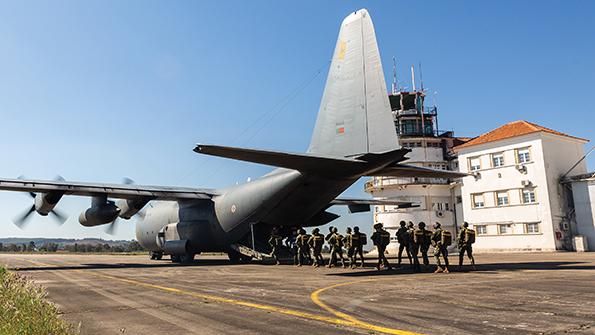
Airlift projects are a top priority for European defense initiatives, with work underway on developing an airlifter to replace types such as the C-130 Hercules, pictured here in Portuguese colors, to boost training and interoperability.
Russia’s invasion of Ukraine appears to be changing perceptions of European institutions as contributors to regional defense.
The defense cooperation mechanisms of the European Union and European Commission may have been slow to gain traction, but today, partly driven by the “wake-up call” of the war in Ukraine, they appear to be driving nations toward closer cooperation through the Permanent Structured Cooperation (PESCO) and encouraging industry to partner on research and technology with European Defense Fund (EDF) monies.
- Strategic airlift requirements receive high priority
- Defense fund and PESCO bolster Europe’s ability to respond to new threats
The initiatives are driving the development of weapons and technologies for combat aircraft and helicopters, as well as defenses against advanced threats such as hypersonic missiles.
Via the EDF, hundreds of millions of euros are being funneled into defense companies, small and medium-size enterprises and research institutions across the continent, supporting dozens of research projects that could be crucial to Europe’s defense.
Nations outside PESCO have begun to recognize the potential benefits of the EU’s defense efforts. In April, a framework arrangement was signed by the European Defense Agency (EDA) and U.S. Defense Department for closer cooperation including a mechanism for the exchange of information.
Denmark joined European defense initiatives this year, after a 2022 referendum ended the country’s three-decade opt-out from the EU’s Common Security and Defense Policy. Copenhagen since has joined the EDA and signed up to participate in several PESCO projects.
The UK, which had been vehemently opposed to the EU’s defense policy before withdrawing from the union after the Brexit referendum, received approval in October to join the Military Mobility PESCO project, and Canada was invited to join the Network of Logistic Hubs in Europe and Support to Operations PESCO project in February. Both Denmark and the UK had favored NATO membership as their primary tool for security and defense.
“Beyond the operational lessons, this war has also made it clear that we need a broader, more resilient and more reactive industrial and technological base,” Josep Borrell, EU High Representative for Foreign Affairs and Security Policy, wrote at the end of May.
A reactive industry, Borrell said, is a “fundamental building block” of Europe’s defense. “Such a base must help increase the readiness of European militaries and produce weapons that member states can use together, to be interoperable in the NATO framework,” he noted.
The EDA now is calling on member states “to develop capabilities at scale across all domains,” Chief Executive Jiri Sedivy wrote in the agency’s annual report. “Russia’s invasion underlines the need for a full spectrum of military capabilities.”
Europe’s mechanisms for defense cooperation have been developed to meet two aims. PESCO is focused on deepening national cooperation, closing capability gaps and encouraging greater commonality between countries to help avoid duplication of effort and feed the development of new multinational programs.
These efforts are supported by the EDF, which aims to strengthen Europe’s defense industry and capabilities by funding research and development for projects such as those created through PESCO. The EDF has a budget of €7.9 billion ($8.5 billion) for 2021-27.
Today, there are 68 multinational PESCO projects and dozens of EDF-funded research entities, and the latest call for proposals to industry covers 34 topics worth a combined €1.2 billion. That call is due to be opened in mid-June.
In May, the European Council adopted 11 PESCO projects, backed by 15 countries. They included German-led work on a Future Short-Range Air-to-Air Missile and efforts spearheaded by France to develop a Next-Generation Medium Helicopter and create a European Defense Airlift Training Academy. The upcoming call for proposals for EDF funding includes studies into radar detection and avoidance for uncrewed aircraft systems, aircraft self-protection systems, smart systems for future combat aircraft and strategic airlift capabilities for Europe.
The requirements of individual governments, however, still challenge European efforts.
The report card of the various European defense initiatives, the Coordinated Annual Review on Defense (CARD) published by the EDA, states that while PESCO and the EDF have the support of member states, they have not reached their full potential, in part due to the COVID-19 pandemic.
“National defense planning remains mainly focused on repairing the past through satisfying urgent and previously deferred requirements, rather than winning the future by investing in innovative and possibly common capabilities,” CARD states, adding that member states continue to make defense procurement decisions “in isolation without considering their medium-to-long-term impact on the EU defense landscape.”
Despite these issues, industry’s view is that the European initiatives are not only valuable for research funding, but also could tackle European capability gaps NATO would not necessarily address.
In terms of the aerospace projects supported by the European initiatives, one of those deemed most crucial and high-impact is the Strategic Air Transport for Outsized Cargo (SATOC) program, a PESCO initiative led by Germany and backed by France, the Netherlands and the Czech Republic. CARD describes SATOC as creating a high-impact capability goal for European nations, as the current strategic airlift options, Antonov An-124s operated by Ukraine, are expected to reach the end of their service lives by 2030, and no replacement platform is being planned.
The Antonov fleet has been crucial to NATO efforts in Afghanistan, for example, as it is the only platform capable of airlifting some European equipment.
A French Senate report published in 2020 suggested 10-15% of cargo cannot be transported by Europe’s airlift fleet of the Airbus A400M, Lockheed Martin C-130 Hercules and Boeing C-17 if they are needed to project military power. European countries also are exploring development of a new medium airlifter that could replace Europe’s aging C-130s. The Future Medium-Size Tactical Cargo PESCO project could lead to the European development of a next-generation tactical air mobility capability, with work underway by France, Germany, Spain and Sweden and supported by the EDA. Airbus also is leading a European consortium to study the requirement, the company’s annual report reveals.
Significant investment is being plowed into development of hypersonic defense capabilities, too, aligning with the PESCO project. Timely Warning and Interception with Space-Based Theater is a multinational project aimed at developing a European hypersonic defense system.
In 2021, a team of 14 companies from seven European countries, initially led by Spanish company Sener and now headed by Sistemas de Misiles de Espana (Spanish Missile Systems), secured a €100 million EDF grant to begin studies into development of a European Hypersonic Defense endo-atmospheric interceptor. The concept program is to begin in the coming months and last three years. These efforts will be bolstered by a second sourced team led by France-based MBDA, which also is to receive €80 million from the EDF for its work on a hypersonic interceptor. More information about the project is expected to emerge at the Paris Air Show.
The European Commission says it decided to double-source on development of the interceptor because there was no counter-hypersonic missile capability available in Europe.
“Dual-sourcing minimizes the risk of failure on the timely delivery of crucially important defense systems, while also benefiting from the innovation potential of different perspectives,” a European Commission official explains.
The EDF is supporting industry efforts to develop a technology road map for European military rotorcraft as well. The €40 million European Next-Generation Rotorcraft Technologies (ENGRT) efforts, led by Airbus and Leonardo with support from industry in 12 EU countries, are running in parallel but separate from NATO’s Next-Generation Rotorcraft Capability, which is led nationally through the NATO Support and Procurement Agency. The ENGRT efforts aim to prepare technologies that could allow a European country to answer the NATO rotorcraft requirement (AW&ST March 13-26, p. 24).
The EDF also is supporting development of new-generation combat aircraft with studies into fighter cockpit technologies and interoperability between future platforms, while the Novel Energy and Propulsion Systems for Air Dominance project, known as Neumann, is exploring next-generation combat aircraft propulsion and energy management systems and how fighter aircraft energy management can address issues around mission profiles, low-observability capabilities and extending range and lowering life-cycle costs.
In the shorter term, the EU initiatives are driving down the costs of ammunition with large-scale orders across 25 countries, and the Act in Support of Ammunition Production is helping to support industrial production capacities.
